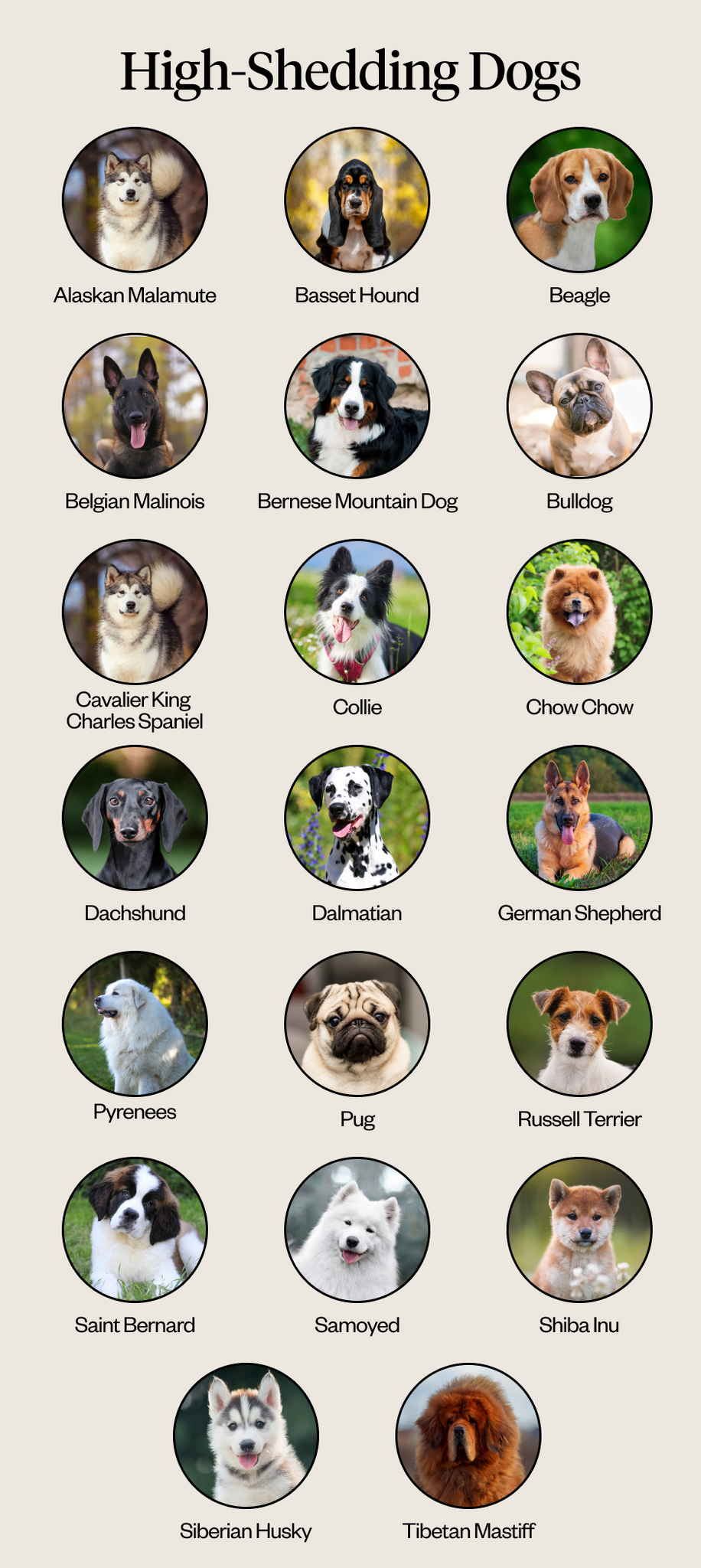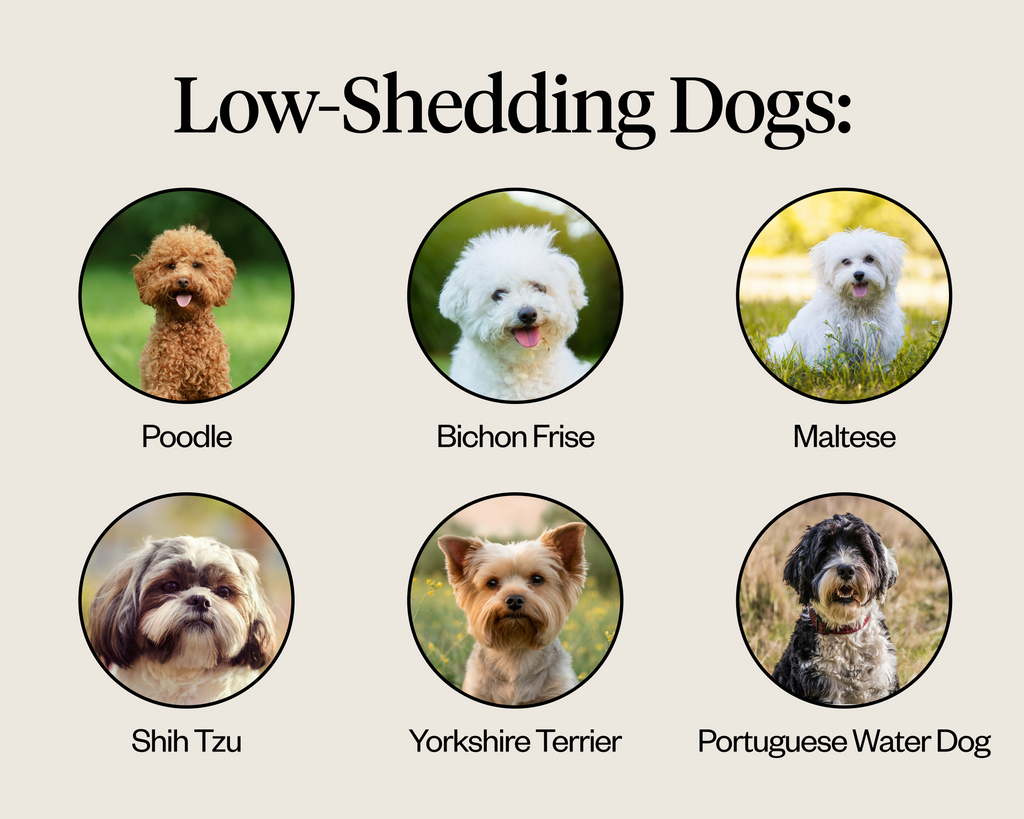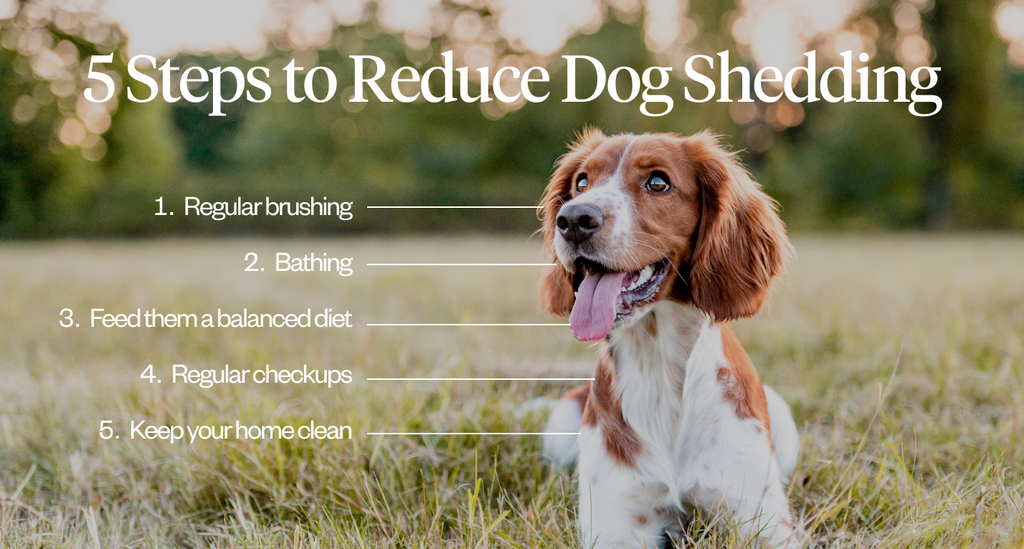11 Min Read
How To Reduce Dog Shedding
Key takeaway
Dog shedding is a natural process that allows dogs to lose old or damaged hair to promote a healthier coat and skin. Unfortunately for pet owners, this often means finding fur around the house and on furniture and clothing. While you can’t prevent shedding, there are ways to manage it, such as brushing and bathing your dog, feeding them a balanced diet, and monitoring them for underlying health issues.

Why pet owners are switching to online vet care with Dutch
-
Prescriptions delivered free to you
-
Fast access to Licensed Vets over video
-
Unlimited video visits and follow-ups
Dog shedding is a natural process for losing old or damaged fur or hair. Some shedding is to be expected, especially with certain breeds. However, excessive shedding can leave pet parents constantly having to lint-roll their wardrobes and furniture.
Beyond the hassles of extra cleaning, knowing how to reduce dog shedding benefits their health and coat. By managing shedding, pet parents can maintain a cleaner living environment while monitoring any unusual hair loss patterns that may indicate underlying health issues.
Keep reading to learn how to reduce shedding in dogs.
Why do Dogs Shed?
Dogs shed as part of their natural lifecycle for various reasons rooted in biology and evolution. Put simply, dogs shed to improve their skin and fur health, allowing them to get rid of old or damaged hair.1 However, there are several other reasons why dogs shed, and why some dogs shed more than others.
- Seasonal shedding: Seasonal shedding occurs when dogs grow thicker coats in the winter to stay warm and shed them in the spring to help them stay cool during summer.2 This process is especially common in dogs who live in places with extreme shifts in weather.
- Coat health: Dogs naturally shed damaged or old fur, allowing new growth.1 Regular shedding ensures the coat is healthy and can protect the dog through temperature regulation.
- Underlying health issues: Some dogs may experience shedding as a symptom of an underlying health issue, such as allergies, hormonal imbalances, fungal infections, or various diseases. If you notice changes in your dog’s coat and skin, such as bumps or a rash, schedule an appointment with your vet as soon as possible.2
- Poor nutrition: Poor nutrition or deficiencies in nutrients can lead to increased shedding because it causes weakened hair follicles.2 Most high-quality dog foods contain all the essential vitamins and minerals needed to promote healthy hair growth and reduce excessive shedding.
- Stress: Dogs may shed more when they’re stressed or anxious.2 For instance, you may notice your dog shedding more when they’re waiting at the vet’s office or going for a car ride.
If you’re concerned about your dog’s shedding, consult a vet through our telemedicine for pets platform.
High-shedding vs. low-shedding dogs

Some breeds shed more than others. It’s a common misconception that the longer the coat, the more a dog will shed. Instead, various factors influence how much a dog sheds, including their breed. High-shedding dogs can either have dense double coats with the undercoat shedding most heavily during seasonal changes. However, single-coat dogs can also experience high shedding. Dogs that shed the most include:
- Alaskan Malamute
- Basset Hound
- Beagle
- Belgian Malinois
- Bernese Mountain Dog
- Bulldog
- Cavalier King Charles Spaniel
- Collie
- Chow Chow
- Dachshund
- Dalmatian
- German Shepherd
- Pyrenees
- Pug
- Russell Terrier
- Saint Bernard
- Samoyed
- Shiba Inu
- Siberian Husky
- Tibetan Mastiff
High-shedding dogs require more frequent grooming, including brushing and haircuts, to minimize shedding. How often your dog needs to be groomed largely depends on their coat type.
On the other hand, low-shedding dogs often have hair that grows continuously rather than fur, which grows to a certain length before shedding. These dogs lose fewer hairs, and many are considered “hypoallergenic.” While there’s technically no such thing as hypoallergenic dog breeds because the allergen is dander, not fur, these dogs don’t shed as much, meaning they’re putting less dander in the air and on furniture and clothing.

Low-shedding dog breeds include the following:
- Poodle
- Bichon Frise
- Maltese
- Shih Tzu
- Yorkshire Terrier
- Portuguese Water Dog
Just because a dog is low shedding doesn’t mean they don’t require regular grooming. Because many have hair that continuously grows, they may have to visit a professional groomer more often for haircuts while you brush their fur at home to prevent tangles and matting. Many low-shedding dogs are considered higher maintenance because of their grooming needs.

5 Steps to Reduce Dog Shedding
Some dogs shed year-round, while others shed more seasonally. Unfortunately, because shedding is a natural process, you can’t prevent it from happening. It’s essential for your dog’s skin and coat, so while it may be inconvenient for you, it’s a necessity for them.3
That said, there are several ways to manage dog shedding at home. Using dog care essentials like brushes, dog shampoo, a healthy diet, and supplements can reduce shedding by supporting healthy skin and coats. Here are some tips to help you learn how to reduce dog shedding in the house:
- Regular brushing: Regular brushing is one of the most effective ways to manage and reduce dog shedding. Brushing your dog at least three to four times a week can help you reduce the amount of hair they shed around the house.3 Brushing removes loose hairs before they fall out, stimulates the skin, and distributes their natural oils throughout the coat for optimal health. Dogs with dense fur may benefit from a shedding tool designed specifically to reduce shedding. For dogs with short coats, you can use a metal or plastic-tipped comb.3
- Bathing: Bathing with a moisturizing shampoo can help reduce excess loose hair while helping with skin irritation or dry and flaky skin.3 Look for a dog shampoo that’s made without chemicals or artificial colors that can contribute to irritation. Instead, consider natural dog shampoos that can help the skin maintain its pH balance.3 Keep in mind that you shouldn’t over-bathe your dog because it can dry out the skin.
- Feed them a balanced diet: Ensure your dog’s diet is rich in essential fatty acids like Omega-3 and Omega-6. These fatty acids are critical in maintaining healthy skin and a lustrous coat. While high-quality dog food should contain enough nutrients to maintain your dog’s skin and coat health, your vet may also suggest supplements to promote healthy skin.3
- Regular checkups: You should monitor your pet for signs of illness, particularly those that may cause them to shed excessively or have a dry or dull coat. Everything from flea and tick reactions to allergies and infections can increase shedding.3
- Keep your home clean: While you can’t prevent your dog from shedding, you can prevent their shedding from interfering with the cleanliness of your home. You can use furniture covers in areas where your dog spends most of their time, but typically vacuuming will offer the best results. If you have a dog that sheds more frequently, you should vacuum more often. For clothes, you can use a lint roller. You can also use air filters to reduce pet hair in your home.4
With Dutch, you can shop dog products that support healthy skin and coats and have them delivered to your door.
FAQs
What triggers shedding in dogs?
There are various potential triggers of shedding in dogs. Some dogs shed year-round, while others shed more during certain seasons. Breeds with a dense double coat, like Huskies or Retrievers, shed more heavily to adapt to seasonal changes and temperature shifts. On the other hand, breeds with continuously growing hair shed less. Many dogs tend to shed more during seasonal transitions like spring and fall to prepare for warmer or cooler weather.
A dog’s diet and health can also influence their shedding frequency. Dogs with poor nutrition or underlying health issues are prone to shedding more. Essential fatty acids can support overall skin and coat health.
Another trigger for shedding in dogs is anxiety. When dogs are stressed or anxious, they may shed more. Therefore anything from changes in routine to thunderstorms and vet visits can cause your dog to shed more.
Dogs with skin issues may experience more shedding and balding in some cases. For instance, dogs with allergies or skin infections may shed more as their body responds to these underlying issues.
Age may also play a role in shedding. Puppies shed to transition to their adult coat. On the other hand, older dogs may experience coat changes that make them shed more as they age.
What month do dogs shed the most?
Dogs that shed seasonally will shed the most in the spring and fall. Shedding may begin in the late winter and peak in early spring to make way for a lighter coat to better regulate their temperature in hot weather. As the days get longer and temperatures increase, dogs will shed their winter coats for a lighter summer coat.
Dogs may also begin shedding in the late summer and early fall to prepare for winter. They shed their lighter summer coats to grow denser, warmer coats for the winter months.
However, keep in mind that some dogs shed year-round but might experience peak shedding seasons. Geographical location may also influence the shedding seasons. Areas with seasonal changes may cause more excessive spring and fall shedding. On the other hand, shedding may be consistent in more temperate climates.
How often should I take my dog in for grooming?
How often you take your dog in for grooming largely depends on their breed and coat type. Some dogs don’t need to be professionally groomed. Instead, they may benefit from occasional brushing. Short-haired dogs like Beagles may only require grooming to address shedding and nail trims. On the other hand, long-haired breeds with hair that continuously grows will need to visit the groomer more frequently.
In general, most dogs will need a grooming session every 4-8 weeks to maintain healthy skin and coats, but you can consult your vet to determine the best grooming schedule for your pet based on their specific needs.

Final Notes
Learning how to help reduce dog shedding is crucial for maintaining a clean living environment and ensuring your pet's health. Dog shedding is a natural process that varies depending on the dog's breed, health, and age.
To effectively reduce shedding, pet parents should prioritize regular brushing and bathing, a balanced diet, and periodic vet checkups to rule out underlying health issues. Addressing skin issues and allergies can significantly impact your dog’s shedding.
Talk to a Dutch vet if you notice changes in your dog’s skin, coat, or shedding patterns. Our licensed vets can diagnose and treat skin issues and underlying health conditions that can contribute to excessive shedding. Try Dutch today.
Share
References
-
“Dog Shedding: How to Stop or Reduce Excessive Shedding.” WebMD, 11 July 2023, https://www.webmd.com/pets/dogs/excessive-shedding-dogs.
-
“Why Do Dogs Shed?” PetMD, 8 June 2020, https://www.petmd.com/dog/care/why-do-dogs-shed.
-
“Brushing up for Shedding Season.” VMBS News, 8 Dec. 2022, https://vetmed.tamu.edu/news/pet-talk/reduce-dog-shedding/.
-
“How to Stop a Dog from Shedding so Much.” PetMD, 5 May 2020, https://www.petmd.com/dog/grooming/hair-apparent-how-stay-ahead-pet-shedding.



